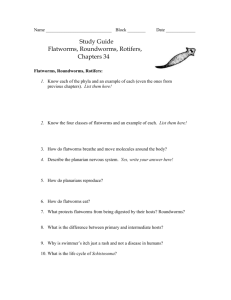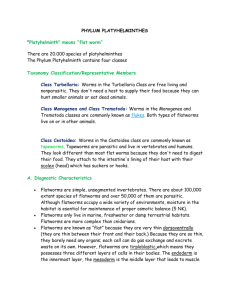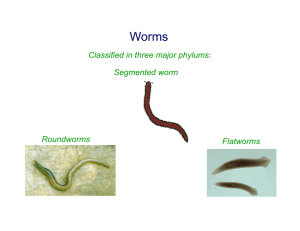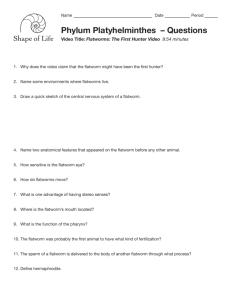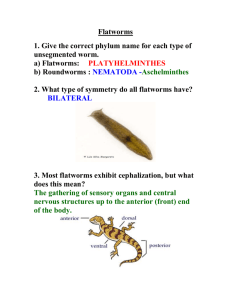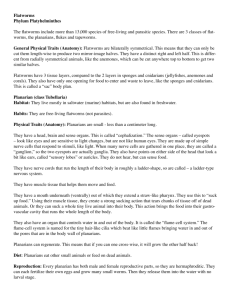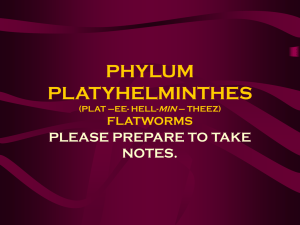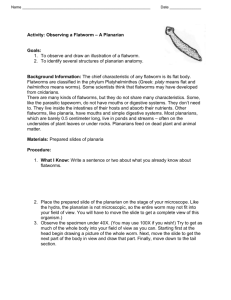There are 20.000 species of platyhelminthes
advertisement
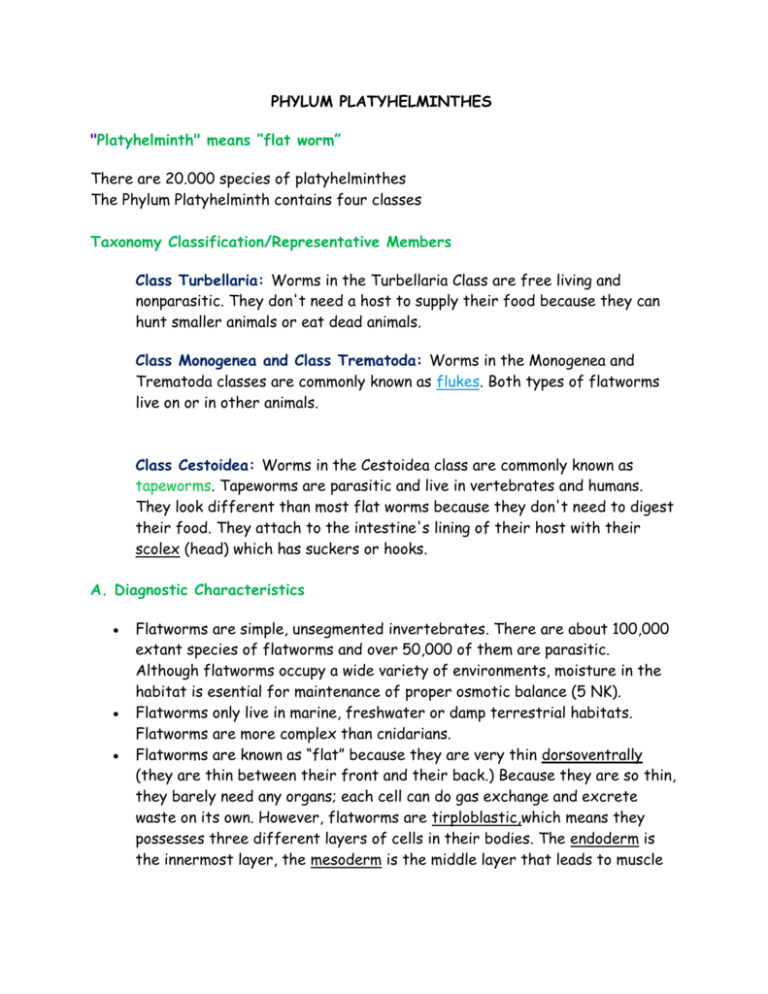
PHYLUM PLATYHELMINTHES "Platyhelminth" means “flat worm” There are 20.000 species of platyhelminthes The Phylum Platyhelminth contains four classes Taxonomy Classification/Representative Members Class Turbellaria: Worms in the Turbellaria Class are free living and nonparasitic. They don't need a host to supply their food because they can hunt smaller animals or eat dead animals. Class Monogenea and Class Trematoda: Worms in the Monogenea and Trematoda classes are commonly known as flukes. Both types of flatworms live on or in other animals. Class Cestoidea: Worms in the Cestoidea class are commonly known as tapeworms. Tapeworms are parasitic and live in vertebrates and humans. They look different than most flat worms because they don't need to digest their food. They attach to the intestine's lining of their host with their scolex (head) which has suckers or hooks. A. Diagnostic Characteristics Flatworms are simple, unsegmented invertebrates. There are about 100,000 extant species of flatworms and over 50,000 of them are parasitic. Although flatworms occupy a wide variety of environments, moisture in the habitat is esential for maintenance of proper osmotic balance (5 NK). Flatworms only live in marine, freshwater or damp terrestrial habitats. Flatworms are more complex than cnidarians. Flatworms are known as “flat” because they are very thin dorsoventrally (they are thin between their front and their back.) Because they are so thin, they barely need any organs; each cell can do gas exchange and excrete waste on its own. However, flatworms are tirploblastic,which means they possesses three different layers of cells in their bodies. The endoderm is the innermost layer, the mesoderm is the middle layer that leads to muscle tissue and the gastrovascular cavity, and ectoderm is the outermost layer that turns into skin. The head of flatworms are usually off-set in some way that makes the head distinguishable from the other parts of a flatworm. On this head are usually a very simple form of eyes (12 BL). Flatworms, similar to radiate animals (organisms that resemble a barrel with equal parts sticking out like the spokes of a wheel), have a gastrovascular cavity (area of digestion with a way to send the food to the rest of the body) with one opening. Because flat worms are so dense and do not have any open cavities (spaces) around their gastrovascular cavity, they are called acoelomates (a solid organism with no space between the gut and the outer body.) The skin of flatworms is soft and ciliated-this means it is covered with cuticules and with external suckers or hooks(or both for connection to a host organism) (7 VM). Flatworms are bilaterally symmetrical organisms, meaning their right and left sides are mirror images (this also implies that flatworms have a defined and distingushable top/bottom and head/tail). (8 Nangia) The anatomy of a typical flatoworm. Notice the lack of a body cavity. (JAC) http://kentsimmons.uwinnipeg.ca/16cm05/16labman05/lb5pg5_files/flatworm2.jpg B. Acquiring and Digesting Food · Digestive is system incomplete- flatworms have a mouth but no anus(7 VM). The system is typically very branched(7 VM). On the stomach of a planarian, there is a muscular pharynx (where food and air are swallowed). When the planarian finds food, stomach juices are sprayed on the prey spreads out in the worm into three branches that have smaller sub-branches so all the cells in the worm can be fed. The mouth is at the end of the pharynx that is far away from the body. It ingests food, and excretes undigested waste. · Tapeworms have no need for a digestive system. The hooks and and suckers on the scolex allow the tapeworm to absorbs the digested food from the host's intestines. C. Sensing the Environment · On a planarian's head, there are two eyespots that sense light, and lateral flaps that allow the flatworm to smell for its prey or other dead animals. The planarian also uses its nervous system to sense and react to the environment. Planarian’s nervous system is mostly in the middle of the worm and is more complex than a cnidarian's nerve net. On its “head” near the eyespots and lateral flaps, there are ganglia (big groups of nerve cells). The ganglia nerve cords run down the entire length of the worm’s body. The chemical signals sent through the ganglia down the nerve cords allows planarians to change their responses to stimuli. Because planarians have ganglia they can be conditioned and "taught." Research has shown that planarians are light sensitive. In some planarians light sensitive areas are arranged in cups, serving as two eyes. (Jesse Carmen) [10] As a result of the bilateral symmetry, planarians can sense their environment better. The cephalization or specialization at the front of the organism has been show to increase mobility, lead to higher order activity, and increase the reactivity of the organism to its environment. (11 HS) D. Locomotion Flatworms usually move through substrates by gliding along with the aid of their microscopic cilia, minute hairlike organelles, hairs that can be found on the bottom surface. Some flatworms may move through Peristaltic motion, which consists of the worm contracting its muscles around the front forcing its anterior end to form a sharp point. This way of moving is generally slow, but it is very effective and it does not use up a lot of energy. (14) (BMB) ·Planarians move by using cilia on the outside layer of their stomachs. They make a thing layer of mucus so they can move easily with their cilia. Occasionally, they can use their muscles to swim through large areas of water with an undulating motion (a wave like up-down motion.) E. Respiration Flatworms are so thin that all their cells individually have gas available to them. Instead of having special organs to help them release and absorb gas, all their cells do it independently. More specifically, since the flatworm's bodies are so flat, there is no need for any sort of major respiratory system because there is a small enough diffusion distance for gas exchange between the environment and all the organism's cells, so oxygen can be absorbed directly through the organism's outer body. (6) (SS) F. Metabolic Waste Removal · Flatworms metabolic waste is the form of a nitrogen compound (ammonia). The ammonia leaves the flatworm’s body by diffusing right from the thin body into the surrounding water. Flatworms also have a simple excretory apparatus that helps control osmotic balance between the flatworm and its surrounding water. G. Circulation · Flatworms don’t have special organs for circulation since they don't need special ways to respirate. Their nutrients are carried throughout their body by the gastrovascular cavity. This is known as an open circulatory system. As described above an open circulatory system is when there is no blood vessils everything is just in the gastrovascular cavity.(SJB)(8) Once the food is pulled through the mouth and flows through the pharynx, the nutrients are digested by the cells lining the inside of the cavity and they are sent through the tubes throughout the body to feed the worm's cells. H. Self Protection · In planarians, the ganglia nerve cords that run down the entire length of the worm’s body allow planarians to change their responses to stimuli. This nerve cord runs down the worm's belly instead of its back, a characteristic that separates them from chordates (OZ). They are able to sense when they need to change direction in order to stay alive. I. Osmotic Balance ·Because flatworms are flattened dorsoventrally and only have three layers of cells, many of the flatworm's cells are touching the water they live in. Water is simply used directly from their habitat to fuel metabolic processes. Also, flatworms have a simple excretory apparatus that helps control osmotic balance between the flatworm and its surrounding water. This apparatus is made of flame cells (cilia cells). The flame cells move fluid through branches of the gastrovascular cavity to the outside water. This function allowed some flatworms to evolve in freshwater and damp land areas. J. Temperature Balance Worms in the Turbellaria class are the temperature of their habitat. Their habitats are limited to water bodies and damp terrestrial habitats because they have no means to protect themselves if their habitat gets too cold or too hot. Thus, flatworms are ectotherms - they lack the ability to regulate their own internal temperature.(ER) K. Reproduction ·The reproductive system of each sex is complete with gonads, ducts, and accessory organs. Fertilization occurs internally. The eggs are microscopic, and the development in its life cycle is either direct or with one or more larval stages(7 VM). Planarians can reproduce asexually (without having sex) by regeneration ( regrowth of body parts from pieces of an organism.) The parent breaks itself in two halves by folding in half length wise and the halves re-grow the end that is missing. Planarians also can reproduce sexually. One planarian is a male (makes sperm) and a female (makes eggs), which is known as a hermaphrodite. Sometimes mates cross ertilize (mate with other species) Important terms: Dorsoventral- thin between their front and their back Tirploblastic- possesses three layers of cells in their embryos Endoderm- innermost layer Mesoderm- middle layer that leads to muscle tissue and organ systems Ectoderm- outermost layer Radiate- organisms that resemble a barrel with equal parts sticking out like the spokes of a wheel Gastrovascular cavity- area of digestion with a way to send the food to the rest of the body Acoelomates- a solid organism with no space between the gut and the outer body Flame cells- cilia cells Planarians- The group of flatworms in the group (genus) Dugesia lives in unpolluted ponds and streams; eat dead animals or hunt smaller animals Undulating motion- a wave like up-down motion. Ganglia- big groups of nerve cells. Pharynx- where food and air are swallowed Asexually- with out having sex Regeneration- re-growth of body parts from pieces of an organism. Hermaphrodite – organism that is a male (makes sperm) and a female (makes eggs) Cross fertilize- mate with other species Flukes- Class Monogenea and Class Termatoda Host- the organism that houses and feeds the parasite Scolex- head of a tapeworm Proglottids- sacs of sex organs that make up the body of a tapeworm
